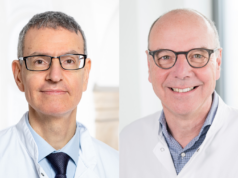
Unnecessary shocks and all-cause mortality are reduced in patients treated with a single chamber implantable cardioverter defibrillator (ICD) programmed with a long detection window.
Lead investigator Maurizio Gasparini (Humanitas Research Hospital, Rozzano-Milano, Italy) presented the findings from the ADVANCEIII trial (Avoid delivering therapies for non-sustained arrhythmias in ICD patients III) at a late-breaking clinical trials session at the Heart Rhythm Society’s 38th Annual Scientific Sessions (10‒13 May, Chicago, USA).
He told delegates: “Even in single chamber ICDs, long detection with ATP [anti-tachycardia pacing] during charging is confirmed to be extremely safe, permitting a significant and dramatic reduction of appropriate ICD therapies, and reduced hospitalisation.”
Several studies have reported that appropriate and inappropriate ICD therapies may be associated with worsening heart failure and increased mortality. Programming strategies can reduce unnecessary ICD shocks, but have only been described for dual or triple chamber ICDs to date. This study aimed to evaluate the effects on unnecessary therapies and mortality of programming a long detection window in single chamber (VVI) ICDs.
Participants in the multicentre prospective trial were 545 patients receiving VVI ICDs, of whom 85% were male, 25% had atrial fibrillation (AF), and 68% had ischaemic aetiology, with secondary prevention indications present in 32%. They were randomised to long detection of 30/40 intervals (267 patients) and standard programming of 18/24 intervals (278 patients), based on device type, AF history, and indication.
ATP therapy during charging was programmed for episodes with cycle length 320‒200ms and shock only for cycle length <200ms in both arms of the trial, with both wavelet and stability functions enabled, so that the only difference between the two arms was the detection length. Hazard ratios and relative 95% confidence intervals (CI) were calculated using the Cox proportional hazards model, with a random effect included to allow for inter-centre heterogeneity. Median follow-up was 12 months.
There were 112 therapies (shocks and ATP) delivered in the long detection group, versus 257 in the control group, giving a 48% reduction with 30/40. Overall shocks decreased by 40% in long detection versus control (48 versus 24, 95% CI=0.38 to 0.94, p=0.026), and appropriate shocks by 51% (34 versus 74, 95% CI=0.26 to 0.94, p=0.033).
Gasparini said: “Appropriate therapy had exactly the same behaviour as overall therapy, with two thirds of divergence [on a graph mapping long detection and standard detection] within one month, and later on they continue to diverge even more impressively than for the overall therapy.”
Survival improved in the long detection arm, although syncope did not differ between groups, and 20 patients died in the control arm versus eight in the long detection arm.
Gasparini described the mortality figures as “a bit astonishing”. He said: “The Kaplan Meier curve is borderline significant, but there is some kind of reduction of mortality.”
However, he conceded: “There are a few limitations for our study. First of all, we do not know the reasons for allocation to single chamber ICD. And the VVI cohort was a little bit different compared to the total cohort with a higher incidence of coronary artery disease, shorter QRS duration, and there were a few patients with left bundle branch block.”
“We have already had at least three major trials pointing out the importance of a long detection window in patients implanted with a dual or triple chamber ICD. But it also seems that in single chamber ICDs, the power of the long detection window is even more important than in the general population. Here we have a 48% reduction of therapy, instead of 37% observed in the general AdvanceIII trial population [for total ICD therapies]. We do not observe any significant effect concerning inappropriate therapies. And while in the overall population of Advance III trial, long detection does not significantly affect mortality, in this subset of patients treated with a single chamber ICD, a borderline mortality reduction has been observed.”
He concluded: “Both total hospitalisations and cardiovascular hospitalisations were dropped by 30%. So the patient has no pain, has no faintness, does not go to the hospital and, with a single chamber ICD and long detection, we have a cut of 50% of mortality.”
Thomas F Deering, HRS 2017 Scientific Sessions Programme chair and moderator at a press conference on the HRS late-breaking clinical trials praised the ADVANCEIII trial as one of the most relevant and interesting of the late-breaking trials presented this year. He said: “With the use of defibrillator therapy we see a significant reduction of sudden cardiac death; however, one of the potential detriments that still remain is that people get shocks and some of them are for inappropriate reasons. What Dr Gasparini showed in his study was that it is possible to decrease appropriate shocks without paying a big price for that, which is syncope or profound arrhythmic symptoms. So if we can take the information that was provided by the ADVANCEIII study augmenting the time-frame to which you recognise inappropriately selected patients and in addition we can increase the rate, and in some cases use discriminators as relevant, we will decrease the number of appropriate shocks. This makes the therapy much more advantageous psychologically for patients and it also makes it much more beneficial in terms of utilisation.”
Full findings can be found at: J Am Coll Cardiol EP 2017 May 11 (Epub ahead of print); 10.1016/j. jacep.2017/05/001.












